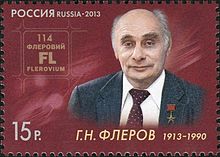You can help expand this article with text translated from the corresponding article in Russian. (November 2015) Click [show] for important translation instructions.
|
Georgii Flyorov | |
|---|---|
Георгий Флёров | |
 The commemorative stamp of Flyorov issued by Russia in 2013 | |
| Born | (1913-03-02)2 March 1913 Rostov-on-Don, Russia |
| Died | 19 November 1990(1990-11-19) (aged 77) Moscow, Soviet Union |
| Resting place | Novodevichy Cemetery, Moscow |
| Nationality | Russian |
| Citizenship | |
| Alma mater | Leningrad Polytechnic Institute |
| Known for | Discovery of spontaneous fission Soviet atomic bomb project |
| Awards | Hero of Socialist Labor (1949) |
| Scientific career | |
| Fields | Physics |
| Institutions | JINR and LFTI USSR Academy of Science |
| Notable students | Yuri Oganessian |
Georgii Nikolayevich Flyorov (also spelled Flerov, Russian: Гео́ргий Никола́евич Флёров, IPA: [gʲɪˈorgʲɪj nʲɪkɐˈlajɪvʲɪtɕ ˈflʲɵrəf]; 2 March 1913 – 19 November 1990) was a Soviet physicist who is known for his discovery of spontaneous fission and his important contribution towards the crystallography and material science, for which, he was honored with many awards. In addition, he is also known for his letter directed to Joseph Stalin, during the midst of World War II, to start the Soviet program of nuclear weapons in the former Soviet Union.
In 2012, element 114 was named flerovium after the research laboratory at the Joint Institute for Nuclear Research bearing his name.